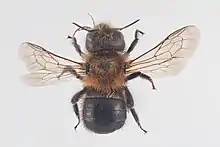Osmia nigriventris
Osmia nigriventris, also known as the large black-bellied mason bee, is a species of solitary bee within the family Megachilidae.
| Osmia nigriventris | |
|---|---|
 | |
| Scientific classification | |
| Domain: | Eukaryota |
| Kingdom: | Animalia |
| Phylum: | Arthropoda |
| Class: | Insecta |
| Order: | Hymenoptera |
| Family: | Megachilidae |
| Genus: | Osmia |
| Species: | O. nigriventris |
| Binomial name | |
| Osmia nigriventris (Zetterstedt, 1838) | |
| Synonyms[2] | |
| |
Description
The exoskeleton of Osmia nigriventris is entirely black with no metallic reflections. The bees body length can range from 10 - 14 mm long.[3] Females possess a strongly thickened clypeal margin[4] and lightly infuscated wings.[5] Males however possess reflexed apicolateral angles of the 5th and 6th tergal segments[4] and subhyaline wings.[5] Both male and female bees have whitish-pale pubescence over the head, thorax and clypeus.[6]
Reproduction
Females of Osmia nigriventris will use their specialized mandibles to excavate nests in wooden substrate such as the thick tree bark of Larix or Pinus species. Suitable nest sites can include either tree bark that is lying on the ground or attached to the remains of standing deadwood, tree stumps and coarse woody debris.[3] Nests will contain from 1 - 26 brood cells, which are constructed within one or several tunnels built by the females. Brood cells are linearly arranged and separated from one another by three-layered partitions made from leaf pulp. The leaf pulp is created from chewed up leaves from genus such as Potentilla and Helianthemum. Pollen provisions are stored in brood cells to provide the offspring with a food source during development.[3]
Depending on the altitude of the nest, adult bees can emerge from the beginning of May to the first decade of June.[3] It is believed that O. nigriventris requires two years to reach maturity in subalpine zones and that the species overwinters as a prepupa during its first winter.[3]
Distribution
Osmia nigriventris has a large distribution and is known to live in both the Neartic and Paleartic zones. It can be found living in North America, where it is present in the states of Oregon, Idaho, Wyoming, Michigan[5] and Minnesota.[7] The species is also present in Canada where it can be found in the territories of Yukon, Ontario, Quebec and Newfoundland. In Europe populations are present in Austria, Czech Republic, Finland, France, Germany, Italy, Lithuania, Poland, Slovakia, Switzerland and European Russia.[8][5] In Asia the bees range extends through Mongolia, Northern China and Russia to far eastern Siberia.[5]
Habitat and ecology
Osmia nigriventris can be found living in open forest, forest edges and meadow habitats in subalpine locations.[3] Females will build their nests in wooden substrate such as the bark of Larix or Pinus trees. Nest sites can include ground resting tree bark or bark attached to the remains of standing deadwood, tree stumps and coarse woody debris.[3] The bee has a preference for flowers from the families Fabaceae (Lotus), Ericaceae (Rhododendron and Vaccinium) and Cistaceae (Helianthemum).[3] Populations have been recorded up to 2250 meters above sea level.[3]
Parasites
The following species are known to be brood parasites of Osmia nigriventris:[3][9]
- Anthrax anthrax - Anthracite bee-fly
- Chrysura hirsuta - Northern Osmia ruby-tailed wasp
- Sapyga similis
References
- "Osmia nigriventris". explorer.natureserve.org. Retrieved 1 November 2022.
- "Osmia nigriventris". Integrated Taxonomic Information System. Retrieved 1 November 2022.
- Müller, Andreas; Prosi, Rainer; Praz, Christophe; Richter, Henning (2019-05-20). "Nesting in bark – the peculiar life history of the rare boreoalpine osmiine bee Osmia (Melanosmia) nigriventris (Hymenoptera, Megachilidae)". alpineentomology.pensoft.net. doi:10.3897/alpento.3.34409. Retrieved 2022-11-01.
- Rightmyer, Molly G.; Griswold, Terry; Arduser, Michael S. (2010-10-07). "A review of the non-metallic 'Osmia (Melanosmia) found in North America, with additional notes on palearctic Melanosmia (Hymenoptera, Megachilidae)". ZooKeys. doi:10.3897/zookeys.60.484. Retrieved 2022-11-01.
- "Osmia nigriventris (Zetterstedt, 1838)". Anthophila- an online repository of bee diversity. 2022-10-31. Retrieved 2022-10-31.
- "Osmia nigriventris (Zetterstedt, 1838)". Discoverlife.org. 2022-11-01. Retrieved 2022-11-01.
- "Minnesota Bees - A Preliminary List" (PDF). Minnesota Department of Natural Resources. 2022-11-01. Retrieved 2022-11-01.
- "Osmia nigriventris (Zetterstedt, 1838)". Fauna Europaea. 2022-11-01. Retrieved 2022-11-01.
- "Chrysura hirsuta (Gerstäcker, 1869)". Artsdatabanken (in Norwegian). 2022-11-01.
